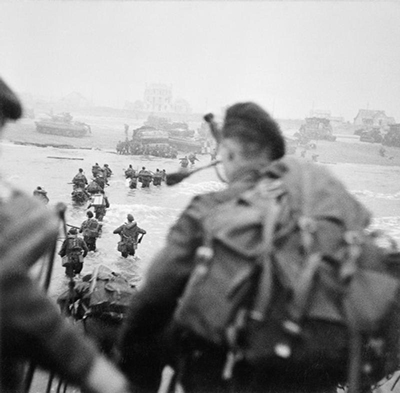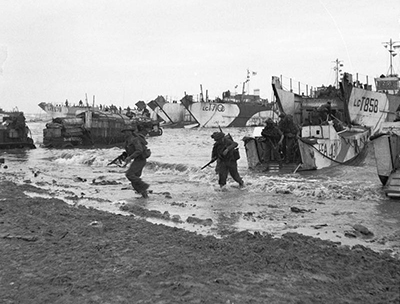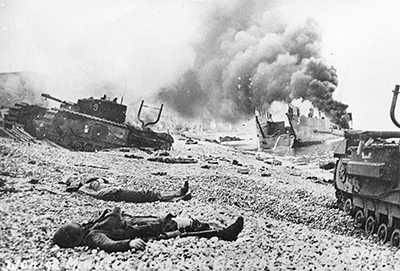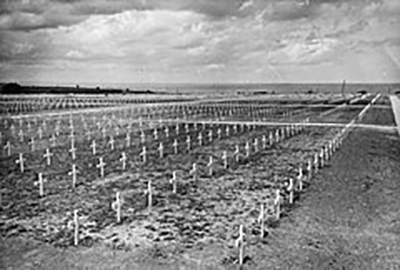Happy New Year.
I took a sabbatical from blogging over the past few months while I’ve been researching my next book in the Breaking Point series, which will focus on D-Day, the Allied invasion of Normandy that took place on June 6th, 1944, 80 years ago this year.
Whenever I research a new book, I am always struck by two thoughts: the first is how little I really know about historical events I assume I understand; and the second is the brutality of the conflict and the appalling cost in casualties and deaths. Research is therefore both a fascinating voyage of discovery and a painful reminder of human suffering.
D-Day is perhaps the most extraordinary day in the history of World War II, and perhaps the most extraordinary in the long annals of military history. The more I dig into it the more astonished I become.
Enemy coast ahead:
Royal Marine Commandos land on Sword Beach and Gold Beach, June 6th, 1944
The story begins before dawn on D-Day as the Allied armada, involving hundreds of ships, approaches the sandy beaches of the Normandy coastline. Awaiting them are the battlements and fortifications of Hitler’s Atlantic Wall, manned by the German Wehrmacht Army Group B commanded by Erwin Rommel, the Desert Fox. Johnnie Shaux is in a landing craft approaching Sword Beach, the easternmost of the five target beaches. Eleanor Shaux is in SHAEF, General Eisenhower’s Headquarters …
LCA 1654, 524 LCA Flotilla (SS Empire Arquebus), Force S, Eastern Task Force, Baie de Seine.
June 6th, 1944, 0630 Hrs
Johnnie Shaux was cold, wet, and acutely uncomfortable, huddled on the deck of a landing craft in the company of thirty other cold, wet, and acutely uncomfortable men. The night seemed preternaturally black. The malevolent wind was making everyone as miserable as it could, whipping the English Channel into an uneven, lumpy chop.
The assault landing craft—officially known, in the Byzantine bureaucratic language of British armed forces, as a ‘landing craft assault’—was chugging through the waves at its torpid top speed of 7 mph. The LCA was rectangular in shape, forty feet long and ten feet wide, a shallow wooden barge with a closed ramp instead of a bow. Every so often a wave would smack into the ramp at just the right angle to spray a deluge of cold seawater over the men aboard. The landing craft was crewed by four Royal Navy hostilities-only ratings whose average age, it seemed to Shaux, was about fifteen, commanded by a pimpled RNVR Sublieutenant who looked somewhat younger.
There were thirty soldiers around him, kernels of darkness in the dark, mostly members of 49 Royal Marine Commando—Four Niner Commando, as it was known. They were, like Shaux, huddled down against the bulwarks in a vain attempt to escape the worse of the weather, loaded down by their big Bergen backpacks and their weapons, festooned with all sorts of equipment held in canvas pouches hanging from their 37 Pattern webbing, crammed together shoulder-to-shoulder along the bulwarks but each alone with his thoughts. Flight Sergeant Cranmer crouched beside Shaux, weighed down not only by his rucksack and equipment but also by the bulk of a portable Set 62 radio with all its accoutrements.
Soon dawn would break and LCA 1654 would reach the coast of Normandy. Shaux reflected that he had often gone into battle, but always in the comparative comfort of a nice dry aircraft cockpit far above the earth and at speeds approaching 400 mph, and it seemed a bit ironic, a bit of a step backwards, that this time he should find himself wallowing along in the swell all the way down here.
SHAEF (Supreme Headquarters Allied Expeditionary Force) Forward, Southwick House, Hampshire, England
June 6th, 1944, 0630 Hrs
Eleanor Shaux stared at the huge map of the English Channel on the wall in Southwick House, General Eisenhower’s tactical headquarters just north of Portsmouth. At the top of the map was the south coast of England, with all the ports and harbors and estuaries from which the invasion fleet was being launched. The middle of the map was the English Channel, with red ribbons marking out mine-swept lanes representing the planned courses of the Operation Neptune invasion fleet.
At the bottom of the map stretched the coast of Normandy, marked with the five beaches that constituted the main Allied landing zones. From west to east—from left to right as she looked at the map—lay the American landing beaches code-named Utah and Omaha, and then the British and Canadian beaches Gold, Juno, and Sword.
The three British and Canadian beaches had originally been given code names standing for fish—goldfish, jellyfish, and swordfish—but Churchill had objected to the notion that men would be asked to die on a beach named ‘Jelly’ and had peremptorily changed it to Juno.
Her eyes were drawn to the rightmost, the most eastern beach, Sword, the landing target for the British 2nd Army’s 3rd Infantry Division. The three-mile-long beach was divided into sectors, Oboe, Peter, Queen, and Roger, and each sector was itself divided, so that Queen was divided into Queen Red and Queen White. There, just to the right—to the east—of the center of the village of Lion-sur-Mer, was Queen Red, and somewhere to the north of Queen Red, somewhere in the pre-dawn darkness, the LSA carrying Johnnie would be butting through the Channel chop.
For the past nine months she had devoted every waking hour to planning for this moment, and it was very hard to realize that it was finally here. It was all supposed to have happened yesterday, but the Channel had been too rough for small landing craft and amphibious vehicles and General Eisenhower, the Supreme Allied Commander, had called for an agonizingly suspenseful twenty-four-hour delay. The weather still wasn’t much better today, but Ike had decided it was just good enough and given the order to proceed. It must have been an excruciating decision, she thought; if Ike played safe and delayed, the next windows for the right tides and phases of the moon were weeks away. If he took the chance and went ahead, the weather could worsen suddenly, and catastrophe might strike the invasion forces.
She glanced up at the big time and date display on the wall: June 6th, 1944, 0630 hrs. This was a moment that would go down in history, one way or the other, she thought: this was H-Hour on D-Day at last.
Dead Canadian soldiers litter the beach at Dieppe, a precursor to D Day; a contemporary photograph of one of many military cemeteries in Normandy












